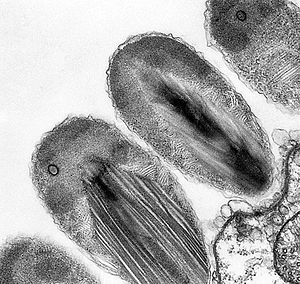Euplotidium
| Euplotidium | ||||||||||||
|---|---|---|---|---|---|---|---|---|---|---|---|---|
TEM-Aufnahme eines Stage-II-Epixenosoms an der Oberfläche von E. itoi (alias Paraeuplotidium itoi).[1] | ||||||||||||
| Systematik | ||||||||||||
| ||||||||||||
| Wissenschaftlicher Name | ||||||||||||
| Euplotidium | ||||||||||||
| Noland, 1937[2] |
Euplotidium ist eine Gattung von Wimpertierchen der Klasse Spirotrichea.[3] Die Arten gehen symbiotische Beziehungen mit Bakterien der Gattung Epixenosoma in Strukturen namens Epixenosomen ein.[4][5]
Verteidigungssymbiose mit Epixenosoma
Die Rückenfläche von Euplotidium (d. h. in dorsaler Lage) kann Bakterien der Gattung Epixenosoma als Epibionten aufzunehmen. Der Name Epixenosoma stammt aus dem Altgriechischen (επι ξενον σομαepi xenon soma) und bedeutet „externer fremder Körper“, was auf ihre extrazelluläre Position auf dem Wirt hinweist. Die Extrusionskörper von Epixenosoma stoßen ihren Inhalt aus, wenn sie ausgelöst werden; dieser Prozess hilft, die Euplotidium gegen Räuber zu verteidigen. Obwohl Euplotidium auch ohne Epixenosomen wachsen und sich vermehren kann, haben diejenigen mit Epixenosomen eine viel höhere Überlebensrate, wenn sie Räubern wie Litonotus (ebenfalls ein Wimperntierchen) ausgesetzt sind.[6]
Systematik
Gattung Euplotidium Noland, 1937:[2][7][8]
- Spezies E. agitatum Noland, 1937[2][9]
- Spezies E. rosati Modeo et al. 2012, früher E. sp. CV-2012
- Spezies E. smalli Lei, Choi & Xu, 2002[9]
- Spezies E. sp. Isolat B376 (Metagenomik)[10]
Nach einem Vorschlag von Lei et al. (2002) werden die bekannten Arten der Gattung Euplotidium, bei denen sich linke Randzirren finden, innerhalb der Familie Gastrocirrhidae verschoben in eine neue
Gattung Paraeuplotidium Lei, Choi & Xu, 2002:[8][9]
- Spezies E. arenarium Magagnini & Nobili, 1964 ⇒ P. arenarium (Magagnini & Nobili, 1964)
- Spezies E. helgae Hartwig, 1980, nach WoRMS ⇒ P. helgae (Hartwig, 1980)
- Spezies E. itoi Ito, 1958[6][5][1] ⇒ P. itoi (Ito, 1958)
- Spezies E. prosaltans Tuffrau, 1985[11] ⇒ P. prosaltans (Tuffrau, 1985)
- Spezies E. psammophilus (Vacelet, 1961) Borror, 1972 ⇒ P. psammophilus (Vacelet, 1961) Lei, Choi & Xu, 2002
Die Mitglieder der neuen Gattung sind Gastrocirrhidae mit trichterförmiger Mundhöhle, frontoventralen und transversalen Zirren, zudem sind linke marginale Zirren vorhanden.[9]
Einzelnachweise
- ↑ a b Moselio (Elio) Schaechter: Ciliate 007. Auf: Schaechter Blog, American Society For Microbiology, 2014.
- ↑ a b c Lowell E. Noland: Observations on marine ciliates of the Gulf Coast of Florida. In: Transactions of the American Microscopical Society, Band 56, Nr. 2, S. 160–171, April 1937; doi:10.2307/3222944, JSTOR:3222944.
- ↑ OneZoom: Spirotrichea
- ↑ Giulio Petroni, Stefan Spring, Karl-Heinz Schleifer, Franco Verni, Giovanna Rosati: Defensive extrusive ectosymbionts of Euplotidium (Ciliophora) that contain microtubule-like structures are bacteria related to Verrucomicrobia. In: Proceedings of the National Academy of Sciences. 97. Jahrgang, Nr. 4, 15. Februar 2000, ISSN 0027-8424, S. 1813–1817, doi:10.1073/pnas.030438197, PMID 10660683, PMC 26518 (freier Volltext) – (pnas.org). ResearchGate.
- ↑ a b Giovanna Rosati: Epixenosomes: Symbionts of the Hypotrich Ciliate Euplotidium itoi. In: Symbiosis. 26. Jahrgang, 20. Oktober 1999, S. 1–23 (dal.ca [PDF]).
- ↑ a b Giovanna Rosati, Giulio Petroni, Silvia Quochi, Letizia Modeo, Franco Verni: Epixenosomes: Peculiar Epibionts of the Hypotrich Ciliate Euplotidium Itoi Defend Their Host Against Predators. In: Journal of Eukaryotic Microbiology. 46. Jahrgang, Nr. 3, 1. Mai 1999, ISSN 1550-7408, S. 278–282, doi:10.1111/j.1550-7408.1999.tb05125.x.
- ↑ NCBI Taxonomy Browser: Euplotidium, Details: Euplotidium (genus); graphisch: Euplotidium, auf: Lifemap NCBI Version.
- ↑ a b WoRMS: Euplotidium Noland, 1937. Die beiden Schalter „marine only“ und „extant only“ bitte deaktivieren.
- ↑ a b c d Yanli Lei, Joong Ki Choi, Kuidong Xu: Morphology and Infraciliature of a New Marine Ciliate Euplotidium smalli n. sp. with Description of a New Genus, Paraeuplotidium n. g. (Ciliophora, Euplotida). In: Journal of Eukaryotic Microbiology, Band 49, Nr. 5, September/Oktober 2002, S. 402–406; doi:10.1111/j.1550-7408.2002.tb00219.x, PMID 12425528, Epub 11. Juli 2005.
- ↑ NCBI Nucleotide: Euplotidium sp. isolate B376.
- ↑ M. Tuffrau: Une nouvelle espèce du genre Euplotidium Noland 1937: Euplotidium prosaltans n. sp.(Cilié Hypotriche). In: Cahiers de Biologie Marine, Band 26, 1985, S. 53–62
Auf dieser Seite verwendete Medien
(c) Grosati in der Wikipedia auf Italienisch, CC BY-SA 3.0
Epixenosomen im Längsschnitt im TEM auf der Oberfläche von Euplotidium itoi (syn. Paraeuplotidium itoi). Man beachte die ungewöhnlich komplexe Struktur der Prokaryoten. Siehe auch Ciliate 007, WoRMS.

